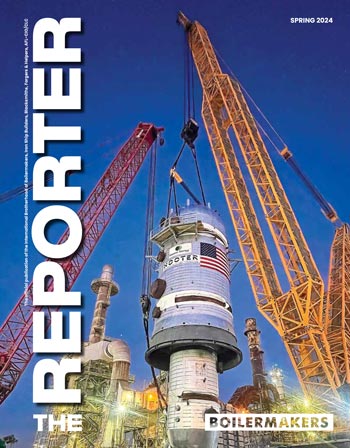Mandate to reduce NOx emissions spells golden opportunity for construction Boilermakers
Construction Boilermakers considering early retirement should look at the increased benefits two more years of steady work can bring. It could be 30 percent or more.
In September, Carol Browner, director of the Environmental Protection Agency (EPA), announced a wide-ranging plan for cleaning up the air in 22 states in the eastern U.S. Her plan mandates reducing smog-causing nitrogen oxides (NOx) emissions by 1.1 million tons by the year 2003, or 28 percent by the year 2007.
This ruling will provide a financial bonanza for construction Boilermakers over the next eight years. One of the most efficient technologies for reducing NOx in fossil-fired boilers is through selective catalytic reduction (SCR). The majority of modifications required for implementing SCR technology in existing boilers is performed by Boilermakers.
The EPA plan provides for a market-based "cap and trade" program to reduce the costs of compliance. In this program, businesses earn "credits" for reducing emissions. These credits can be sold to other businesses. The plan does not specify which sources of emissions should be reduced, but simply sets the target for reduction. In this way, utilities that reduce their emissions can sell excess credits to industries unable to reduce theirs.
Over the next four to eight years, construction Boilermakers will be needed in numbers we haven't seen in a long time. An SCR retrofit generally takes a unit off line anywhere from two weeks to two months. Utilities throughout all of the 22 states named in the plan will need to retrofit equipment. The EPA estimates that compliance measures will cost about $1.7 billion a year. A sizeable portion of that money will go to the Boilermakers who do the work necessary to make the additions and modifications required by the SCR technology.
This is a golden opportunity for Boilermakers. We must work with our contractors to assure their customers that we have the manpower to get this enormous job done. Although the work will be performed in only 22 states, the amount that needs to be done in only a few years time is so great that the local lodges in those areas will no doubt be contacting other lodges to help supply the necessary manpower. They will need experienced, skilled craftsmen. Boilermakers from all over the U.S. and Canada can expect to benefit from the work resulting from the implementation of Browner's plan.
All Boilermakers need to recognize the opportunity - and the challenge - the EPA's mandate provides us. Construction Boilermakers stand to get more hours in the next few years than they've been getting the last few, but only if we can man those jobs. If we cannot provide a reliable source of available, skilled manpower, customers will be forced to go to other sources to get this retrofit work done in the time allotted. That would have a disastrous effect on our future work. We cannot afford to let it happen.
If you're in the apprentice program or are new to the trade, keep developing your skills because Boilermaker contractors are going to need lots of hard-working, highly skilled Boilermakers for this work.
Those Boilermakers who have been considering early retirement in the next year or two should reconsider. By staying in the trade you will be eligible for Health & Welfare coverage - a benefit that is expensive to purchase and very necessary with today's rising medical costs - and the advantage of having a few thousand additional hours in pension contributions is considerable.
According to an analysis by the pension office, if the average Boilermaker works two years beyond age 55 at 1,700 hours each year, he or she will receive an additional $573.68 per month in benefits on retiring at 57. That's nearly $600 per month for the rest of your life just for putting in two more years instead of retiring at 55. Few people in this age group stand to benefit so greatly from sticking it out a few more years.
The extra work generated by the EPA plan will begin showing up soon. Power plants and other facilities will have to rush to meet the EPA's compliance deadlines. The 22 states involved must submit their plans for compliance by September 1999, and controls must be in place by 2003.
A few of the states involved have challenged the EPA's plan, but their lawsuits will not significantly affect its implementation. A plan for NOx reduction similar to Browner's proposal will eventually be agreed upon, and whatever the specific details of that plan, it will require major improvements in lowering NOx emissions, and the utility industry will be doing a great deal of SCR retrofitting over the next four to eight years.
We owe it to our contractors and their customers to provide the manpower needed to do this work as efficiently and safely as possible. Doing so will put money in our members' pockets, increase their pension benefits, and ensure that all of our families breathe cleaner air in the future.
With results like these, we really can't lose.







